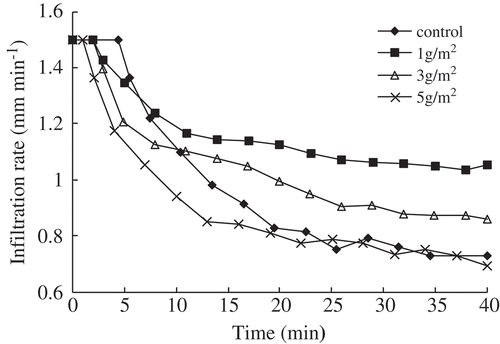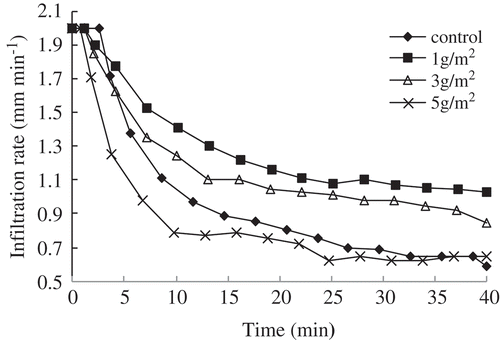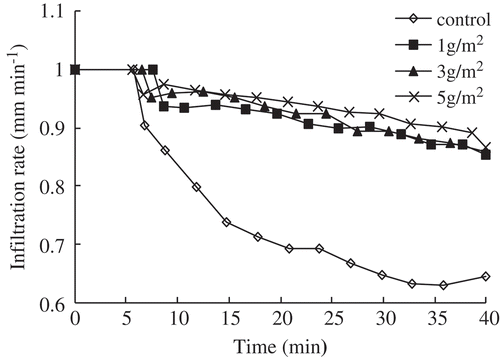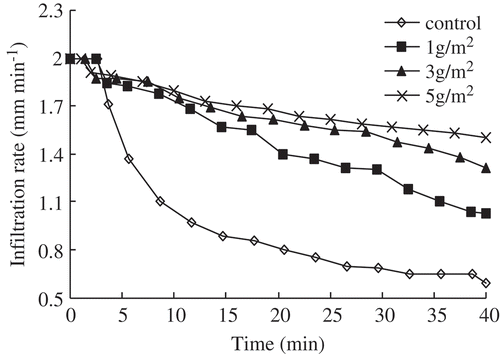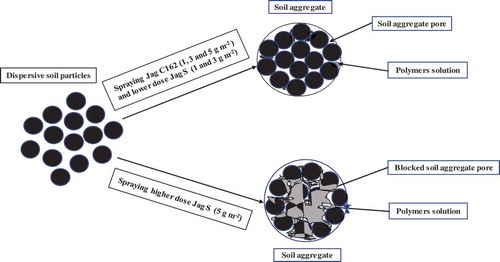ABSTRACT
Developing effective measures to improve soil structure and increase soil infiltration in the Loess Plateau located in arid and semiarid areas is important for soil and water conservation. Simulated rainfall experiments were conducted to determine the effects of two new natural polymer derivatives, namely neutral polysaccharide (Jag S) and cationic hydroxypropyl polysaccharide (Jag C162), on rainfall infiltration and their underlying mechanisms. The proportions of different sizes of water-stable soil aggregates were analyzed after spraying four different concentrations (0, 1, 3, and 5 g m−2) of Jag S and Jag C162 under rainfall intensities of 1, 1.5, and 2 mm min−1 and a slope gradient of 15°. Treatments with Jag S and Jag C162 significantly improved the rainfall infiltration rates (IRs) compared with the control. Moreover, applying 1 and 3 g m−2 Jag S effectively increased the IRs by 22.81% and 13.69%, respectively. Treatment with Jag C162 also increased the rainfall IRs by 39.47%, 46.59%, and 46.50%. Furthermore, the content of >0.25 mm water-stable soil aggregates increased from 27.19% to 90.42% before rainfall and from 9% to 50% after rainfall. Compared with Jag C 162, treatment with Jag S was less effective on improving rainfall infiltration and aggregate content. In particularly, application of 5 g m−2 Jag S improved the soil aggregate content but weakened rainfall infiltration because of the higher viscidity and consistency of the Jag S solution. Overall, spraying appropriate amounts of Jag C162 and Jag S on the loess slope surface can increase the water-stable soil aggregate content, resulting in improved rainfall infiltration and reduced soil erosion. Thus, application of two new natural polymer derivatives is a possible alternative conservation practice in the Loess Plateau.
1. Introduction
Scarcity of food and the increasing of large population has put forward high requirement for the cultivated area in China. The slope cropland reaches up to 10 million hm2 in the Loess Plateau, which accounts for almost one-tenth of the cultivated area in China. Thus, food productivity in the Loess Plateau is very important for agriculture in China. However, arid and semiarid areas in the Loess Plateau possess thick soil layer and loose soil texture and experience simultaneous intense loss of soil and water and drought, which accelerated the degradation of ecosystem functions, reduction in soil productivity, and sustainability of agricultural lands. Raindrops on the surfaces of arid and semiarid areas can easily disrupt soil structure, cause aggregate disintegration, and lead to the formation of a soil crust; these phenomena significantly reduce rainfall infiltration, increase surface runoff, and induce soil erosion and drought. Rainfall infiltration plays a crucial role in slope hydrological circulation by influencing surface runoff rate, soil erosion rate, and drought degree. Therefore, intensifying rainfall infiltration is an important measure used to control soil and water loss, increase the availability of rainfall water resources, reduce drought, and improve agricultural productivity in the Loess Plateau.
The engineering measures (terrace, level bench, slope protection project, and so on) and biological control measures (covering topsoil with residues and planting trees and grasses) are traditional measures used to prevent the adverse effects of soil sealing, namely increasing rainfall infiltration and reducing surface erosion, on the slope cropland of the Loess Plateau. However, this method exhibits many limitations, including sharp decline in soil productivity due to the large area of cropland destruction, as well as the inflammability of the cover materials, the large volume of materials required, sheltering of topsoil from light, and high costs (Hedrick and Mowry Citation1952). Therefore, complementary measures must be used to effectively weaken the impacts of raindrops, intensify rainfall infiltration, and decrease soil and water loss; these measures include chemical regulation by retaining and increasing water-stable soil aggregates and preventing crust formation.
Macromolecule polymers exhibit distinct physical and chemical properties and are used as soil conditioners to improve soil porosity, increase infiltration (Gal et al. Citation1992), enhance soil aggregation (Wallace Citation1986), ameliorate degraded soil, avoid soil sealing formation, and reduce soil erosion (He and Michael Citation1998; Gal et al. Citation1992; Brandsma et al. Citation2001). Santos et al. (Citation2003) found that soil conditioners can reduce crusting, increase infiltration, and control surface runoff and soil erosion. Recent studies have suggested the application of synthetic polymers and surfactants. Scholars have commonly investigated acrylate, polyacrylamide (PAM), polysaccharide polymer, polyvinyl alcohol (PVA), and polyvinyl acetate (PVAc). Botha et al. (Citation1980) investigated the influence of PVA on the liquid–solid contact angles of fine sandy soil. Pini and Vigna (Citation1994) reported that soil micro-aggregation occurred when using two uncharged polymers, namely PVA and dextrans, and studied the interaction of water-soluble stabilizing agents with soil particles. Floyd (Citation1981) studied the use of PVAc emulsion as soil conditioner.
PAM is one of the most widely studied synthetic polymer soil conditioners. Using PAM as soil conditioner can improve topsoil structure and increase rainfall infiltration due to its adhesion properties (Lei et al. Citation2003). According to Chan and Sivapragasam (Citation1996), the addition of an anionic polymer (PAM) significantly improved hard-setting soil physical properties including increased water-stable aggregate content and reduced tensile strength and bulk density at the lowest application rate (0.001%); these effects increased with increasing rate of application. Many studies provided a detailed discussion regarding the use of PAM to effectively maintain soil structure and formation of soil aggregates by adsorbing soil particles, thereby significantly increasing the soil IR in simulated experiments. The effectiveness of PAM is related to clay content in soil and the molecular weight and charge density of PAM (Vacher et al. Citation2003). In addition, Sepaskhah and Bazrafshan-Jahromi (Citation2006) showed that application of high amounts of PAM can effectively maintain the high IR. Ben-Hur and Letey (Citation1989) observed that applying 10 g m−2 polysaccharides to sprinkled irrigation water significantly increased the IR; however, the effect of polysaccharides on infiltration depended on the types of polysaccharides.
Although application of macromolecule polymers, especially PAM, positively affects rainfall infiltration, they exhibit certain limitations, such as unsatisfactory impact on low-quality or salty soils and dependent of effects on chemical materials and soil properties (Lentz Citation2003; Lu et al. Citation2002). Some authors have attempted to improve the properties of soil by integrating it with different chemicals. For example, to pursue better polymers, Liu et al. (Citation2014) studied the effect of new polymers (NPDs) on the sheet erosion of experimental loessial slopes through simulated rainfall experiments. NPDs effectively delayed the onset of runoff and reduced the volume and sediment content by significantly increasing the shear strength and the contents of large aggregates on the soil surface. Therefore, new and effective macromolecular polymers must be developed to meet the needs for chemically regulating rainfall infiltration to reduce surface runoff and induced soil and water loss for various types of soil.
Jag S and Jag C162, which are SOLVAY polymers extracted from bean embryo, are two new natural polymer derivatives used in our research. These polymers are green chemical and do not have irritating and adverse effects on aquatic species where they were tested. These materials cost 10 yuan per kilogram, and approximately 100 yuan per hectare, application of these polymers to ground surface is considered economical. This study aims to explore the effects of applying different concentrations of the two new synthetic polymers (Jag S and Jag C162) on rainfall infiltration and reveal their possible underlying mechanisms. The proportions of water-stable soil aggregates of different sizes were analyzed after Jag S and Jag C162 spray treatments under simulated rainfall.
2. Materials and methods
2.1. Soil and polymers
Soil samples used for testing were obtained from Ansai County in the hinterland of the Loess Plateau (a typical region with hills and gullies). Ansai (109°19′E, 36°51′N) is located in northern Shaanxi Province and experiences a mean annual temperature of 8.8°C and annual precipitation of 500 mm. A silt loam (USDA) agricultural soil was sampled at depths of 0–25 cm; the sample exhibited the following properties: organic matter content of approximately 0.5%, d 50 of 0.037 mm, clay content of 8.7%, silt content of 54.7%, and sand content of 36.6%. The soil samples were air dried, crushed, mixed, and passed through a 10-mm sieve. The tested polymeric compounds included the natural polymer derivatives of neutral polysaccharide (Jag S) and cationic hydroxypropyl polysaccharide (Jag C162), which are both SOLVAY (a company) powder polymers extracted from bean embryo. Jag S is electrically neutral, whereas Jag C162 consists of cationic hydroxypropyl. In addition, these derivatives are cost effective and considered green chemicals because they have no irritating or adverse effects on aquatic species.
2.2. Equipment
Experiments were conducted in the Simulated Rainfall Hall at the State Key Laboratory of Soil Erosion and Dryland Farming on the Loess Plateau at the Institute of Soil and Water Conservation (Chinese Academy of Science and Ministry of Water Resources in China). A rainfall simulator system with a side-sprinkler was used to apply simulated rainfall. This rainfall simulator can be set to rainfall intensity ranging from 0.5 to 3.5 mm min−1 by adjusting water pressure and nozzle sizes. The fall height of the raindrop from the top to the soil slope surface is 16 m. The uniformity of simulated rainfall is greater than 80%. The kinetic energy of the raindrop to strike the soil slope surface at rainfall intensities from 1 to 2 mm min−1 ranges from approximately 365 to 847 J h−1·m−2, and the diameter of the raindrops ranges from approximately 0.25 to 0.375 mm.
Experimental plots were constructed using metal frames with dimensions of 1.2 m (length) × 0.4 m (width) × 0.25 m (depth) and adjustable gradients via a movable base. A metal outlet at the lower end allowed for the collection of runoff samples. At the bottom of the plots, many holes were drilled uniformly and a 5-cm-thick layer of natural sand was packed with permeable gauze to allow free drainage of excess infiltration water, the d 50 of natural sand overlaid with permeable gauze is 0.39 mm, with 2.58% clay (<0.002 mm), 3.94% silt (0.002–0.02 mm), fine sand 17.31% (0.02–0.2 mm), and coarse sand 76.17% (0.2–2 mm). The soil was packed to a depth of 20 cm in four 5-cm-thick layers with a bulk density of 1.2 g cm−3 (measured in the compacted state by a cutting ring). Before packing, the water content of the soil was adjusted to 14%, which is the typical water content during the flood season on the Loess Plateau (when most erosion occurs). After the soil was packed, the solutions dissolving enough Jag S and Jag C162 at 1, 3, and 5 g m−2 were prepared by putting Jag S and Jag C162 powders in 2 L of water to produce final Jag S and Jag C162 concentrations of 0.024%, 0.072%, and 0.12%, respectively. These solutions were uniformly sprayed on the surfaces of the plots using a high-pressure sprayer and the control plot was sprayed with an equal amount of water (2 L). The simulated rainfall experiments began approximately 15 h later. Four Jag S concentrations (0, 1, 3, and 5 g m−2), three rainfall intensities (1, 1.5, and 2 mm min−1), and a slope gradient of 15°, which was the setup based on the middle slope of the cultivated land ranging mainly from 5° to 25° in the Loess Plateau, were tested with two replicates. The duration of all simulated rainfall events was 40 min.
2.3. Measurements
For each treatment, runoff samples were collected 1 and 3 min after the onset of runoff and then every 3 min until the end of the experiment. After 40 min of rainfall, total runoff volumes were measured using a graduated cylinder and the sediments were dried at 105°C and weighed to calculate the net runoff by total runoff volumes minus the sediment volumes. Next, the amounts and rates of rainfall infiltration were determined using the principle of water balance; the rates of rainfall infiltration (mm min−1) was determined as rainfall intensity (mm min−1) minus the runoff rate (mm min−1) during rainfall. The contents of aggregate in different sizes before rainfall and after rainfall on the surface (0–1 cm) were measured by wet sieving, and the duration of wet sieving was 10 min every sample; the aggregate sizes were divided into the following classes: >5, 2–5, 1–2, 0.5–1, and 0.25–0.5 mm. Each class of aggregates was oven-dried and weighed. Three samples were measured for each treatment and averaged. All data were analyzed in SPSS using one-way ANOVA and least significant difference tests. For all analyses shown in –, a significance level of 0.05 was used.
Table 1. Improvements of infiltration under different rainfall intensities (Jag S).
Table 2. Improvements of infiltration under different rainfall intensities (Jag C162).
Table 3. Effects of Jag S and Jag C162 on >0.25 mm water-stable soil aggregate content before rainfall.
Table 4. Effects of Jag S and Jag C162 on >0.25 mm water-stable soil aggregate content after rainfall.
3. Results
3.1. Effects of Jag S on rainfall infiltration
– show the effects of Jag S on rainfall infiltration. The rainfall IR decreased rapidly during the first 30 min of rainfall and was stabilized when the final infiltration rate (FIR) was obtained as the rainfall continued for the three concentrations (1, 3, and 5 g m−2 Jag S) at the three rainfall intensities (1, 1.5, and 2 mm min−1) for a slope gradient of 15°. This trend was similar to that observed in the absence of Jag S (control), and the changes of the rainfall infiltration with rainfall period potentially resulted from soil moisture variations. During early rainfall, the soil moisture content was low, the infiltration capacity of the soil exceeded the rainfall intensity, and the IR was equal to the rainfall intensity. As the rainfall continued, the IR decreased, likely because the soil moisture content of the topsoil increased or because the effects of raindrops on the soil surface disrupted the soil structure and caused aggregate disintegration, which potentially led to the formation of a soil crust and reduced rainfall infiltration. After the formation of runoff, the surface soil moisture content gradually reached saturation and the IR became stable. However, the IR was relatively high and the rates of decline changed substantially when Jag S was applied, except for the treatment concentration of 5 g m−2 used with rainfall intensities of 1.5 and 2.0 mm min−1.
Figure 1. Effects of Jag S on infiltration rate (IR) with time under a rainfall intensity of 1.0 mm min−1.
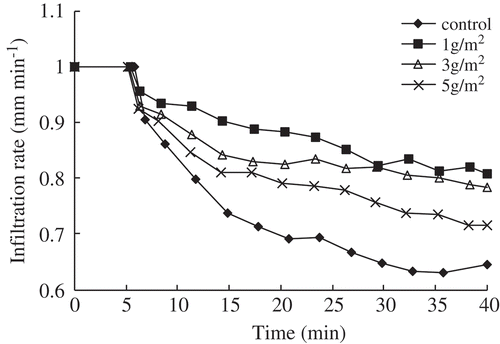
The application of Jag S effectively improved the IR compared with the control under all conditions from –; however, the trends varied under different rainfall rates because of varied doses of Jag S. Generally, the quantity of rainfall infiltration decreased as the concentration of Jag S increased under the same rainfall intensity. This decrease may be attributed to the fact that too high concentration of Jag S solution does not allow it to easily diffuse through the soil to block the soil pore. Thus, except at an application rate of 5 g m−2, the Jag S treatments of 1 and 3 g m−2 were effective for increasing the IR. At the lowest application rate (1 g m−2), the IR was highest. Comparing with the control, we found that the FIR in – demonstrates the ability of Jag S to facilitate higher IRs), except when a dose of 5 g m−2 is used, which produced a lower FIR. The onset of runoff was delayed for each treatment when rainfall intensities of 1.5 and 2.0 mm min−1 were used for the Jag S treatments. However, the runoff when the rainfall intensity was 1.0 mm min−1 occurred nearly simultaneously under different Jag S concentrations.
shows that rainfall infiltration was markedly improved after the application of Jag S. Higher Jag S concentrations resulted in lower IR. No significant relationship occurred between IR and rainfall intensity. However, this lack of correlation mainly resulted from the concentrations of applied Jag S. Comparing with that of the control, we determined that the application of 1 and 3 g m−2 Jag S increased the average rainfall infiltration by 22.81% and 13.69%, respectively, which improved the effects of rainfall infiltration. Conversely, the application of 5 g m−2 Jag S decreased the average rainfall infiltration by 6.3%, which weakened the effect of rainfall infiltration in all experiments. The average quantity of infiltration increased in the following order: 1 g m−2 > 3 g m−2 > 0 g m−2 > 5 g m−2.
3.2. Effects of Jag C162 on rainfall infiltration
The effects of applying Jag C162 on IR with time at three rainfall intensities are presented in –. The IR increased as the rainfall intensity increased, and Jag C162 was effective for maintaining higher IR compared with the control at three tested rainfall intensities. The effectiveness of Jag C162 in terms of IR was dependent on the rainfall intensity and the concentration of applied Jag C162 (–). At the beginning of runoff onset, the reductions in the IR for the three Jag C162 doses were similar. However, after a period of runoff, additional Jag C162 with higher concentrations produced smaller reduction ratios and greater IR at rainfall intensities of 1.5 and 2.0 mm min−1. The changes of the IR in the different concentrations Jag C 162 treatments were similar for a rainfall intensity of 1.0 mm min−1 among the three rainfall intensities.
The application of various doses of Jag C162 on the soil surface significantly increased the infiltration quantity relative to the untreated samples (), with values ranging from 36.86 to 67.05 mm at the different rainfall intensities. Additionally, the quantity of the infiltration increased as the doses of Jag C162 increased, which improved the infiltration under different rainfall intensities. Comparing with the control, we found that Jag C162 increased the average infiltration by 39.47% at 1 g m−2, 46.59% at 3 g m−2, and 46.50% at 5 g m−2. The effectiveness of the Jag C162 polymers regarding IR increased in the following order: 5 g m−2 > 3 g m−2 > 1 g m−2 > 0 g m−2.
3.3. Comparisons of the effects of Jag C162 and Jag S on rainfall infiltration
The combined analysis indicates that the changes in IR associated with the application of different doses of Jag S and Jag C162 were nearly consistent (i.e., the IR decreased gradually and eventually stabilized over time). This trend was similar to that of the control (–). However, these differences were observed: (1) For Jag C162, higher concentrations produced higher IR and quantities, and better improvements in infiltration. Conversely, a gradual decrease was observed in the IR associated with increasing Jag S concentrations, which resulted in lower IR than those of the control at 5 g m−2 Jag S; (2) and show that the average infiltration values under different rainfall intensities (1, 1.5, and 2 mm min−1) on a slope gradient of 15° at 1, 3, and 5 g m−2 Jag S were 42.36, 38.99, and 31.85 mm, respectively. For soil treated with 1, 3, and 5 g m−2 Jag C162, the average infiltration values were 48.16, 50.76, and 50.92 mm, which were higher than those of the Jag S treatments. Therefore, the effects of Jag C162 on rainfall infiltration were more significant than those of Jag S under the same conditions.
3.4. Effects of Jag C162 and Jag S on water-stable soil aggregate content
One effective approach for increasing rainfall infiltration is to prevent the formation of a crust on the topsoil by maintaining the topsoil structure and increasing the aggregate stability. Macromolecular polymers effectively unite the soil particles via viscosity, enhancing the soil structure stability, increasing the aggregate content, and improving the rainfall infiltration. In this study, >0.25 mm water-stable soil aggregates were considered as a primary indicator of the soil structure because their size, quantity, and water stability significantly influence soil pores, permeability, and stability. Generally, higher soil aggregate stability is associated with better permeability and superior IR. Thus, this study analyzed how the application of Jag C162 and Jag S on the topsoil affects >0.25 mm water-stable soil aggregates to clarify the chemical regulation mechanisms of the macromolecular polymers Jag C162 and Jag S, which are associated with rainfall infiltration.
The effects of applying Jag C162 and Jag S on the >0.25 mm water-stable soil aggregate fraction before and after rainfall are presented in and and . Before rainfall, after treatments with 1, 3, and 5 g m−2 Jag S in this experiment, the >0.25 mm water-stable soil aggregate proportion were 56.6%, 73.7%, and 84.7%, respectively, and the three Jag C162 treatments resulted in >0.25 mm water-stable soil aggregate proportions of 82.4%, 90.4%, and 90.3%, respectively. After rainfall, the >0.25 mm water-stable soil aggregate contents exceeded 50% after applying Jag C162 and Jag S and only 9% in the control. After treatments with 1, 3, and 5 g m−2Jag C162 in this experiment, the >0.25 mm water-stable soil aggregate proportion were 51.8%, 62.5%, and 73.2%, respectively, and the three Jag S treatments resulted in >0.25 mm water-stable soil aggregate proportions of 50.85%, 60.19%, and 70.41%, respectively. The addition of Jag S and Jag C162 at 1, 3, and 5 g m−2 increased the >0.25 mm water-stable soil aggregate fractions by 41.9% and 42.8%, 51.2% and 53.5%, and 61.4% and 64.3%, respectively. Obviously, these results demonstrated that the application of both Jag C162 and Jag S significantly improved the >0.25 mm water-stable soil aggregates before and after rainfall, and higher concentrations of Jag C162 and Jag S were correlated with better soil aggregation. In addition, the>0.25 mm water-stable soil aggregate contents of control and different Jag S and Jag C162 treatments before rainfall were higher than those after rainfall and the effect of the application of Jag C162 on >0.25 mm water-stable soil aggregate was better than that of Jag S.
Figure 7. Effects of Jag S and Jag C162 on water-stable soil aggregate content before and after rainfall.
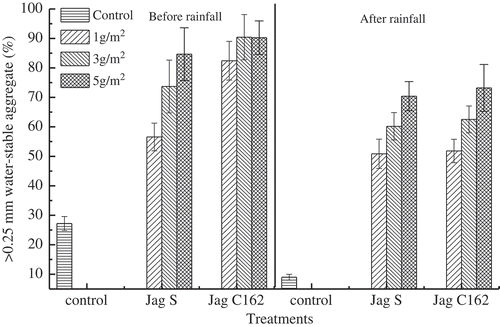
and also show the effects of Jag S and Jag C162 treatments on the different sizes of soil aggregates before and after rainfall. These results are averages of all data at the same concentrations of Jag S and Jag C162. At concentrations of 1, 3, and 5 g m−2, spraying Jag S and Jag C162 effectively promoted the >0.25 mm aggregate content, and the contents of aggregate <0.25 mm were drastically lowered. Before rainfall, spraying different doses of Jag S and Jag C162 effectively improved >0.25 mm contents of water-stable soil aggregates compared with the control. The >0.25 mm water-stable soil aggregate content of the control was only 27.19%, whereas the >0.25 mm water-stable soil aggregate content of spraying Jag S and Jag C162 at 1, 3, and 5 g m−2 reached up to 49.08%, 73.70%, 84.69%, and 82.44%, 90.42%, 90.27%, respectively (). After rainfall, Jag S and Jag C162 improved the contents of different sizes of soil aggregates by 0–24.9%. The application of Jag S and Jag C162 increased the water-stable soil aggregates by 0.3–17.8% and 0.9–12.9% at 1 g m−2, 0.5–17.0% and 3.4–19.1% at 3 g m−2, and 1.7–21.3% and 5.9–24.9% at 5 g m−2, respectively.
Before rainfall, the total amounts of >0.25 mm water-stable soil aggregates of control and spraying different doses of Jag S and Jag C162 were higher than those after rainfall; the content of >5 mm water-stable soil aggregates sprayed with different doses of Jag S and Jag C162 possesses high proportions of all water-stable soil aggregates by 32.69%–61.65% (). However, after rainfall, the proportions of >0.25 mm aggregates were drastically lowered, while the proportions of <0.25 mm aggregates increased (). Otherwise, the proportions of >5 mm, 2–5 mm, and 1–2 mm water-stable soil aggregates associated with the application of Jag C162 for a given concentration before rainfall and after rainfall were greater than those of Jag S, except for the 1–2 mm class at 5 g m−2 before rainfall. In contrast, the proportion of 0.5–1 mm water-stable soil aggregates were higher after applying Jag S than Jag C162 after rainfall. The improvement in the 1–2, 2–5, and >5 mm classes was significant after applying Jag S and Jag C162, especially at the concentrations of 3 and 5 g m−2 (). Thus, before and after rainfall, the Jag C162 treatment was more effective than the Jag S treatment, which indicated that Jag S and Jag C162 can effectively improve water-stable soil aggregates of different sizes by forming larger particles from smaller particles.
4. Discussion
4.1. Improving effect of Jag S and Jag C162 on rainfall infiltration and aggregate
Soil and water loss is currently a very serious problem for agricultural lands especially in the loessial hillslope. Raindrops often break soil aggregates into loose soil particles when a short-time rainstorm occurred on the bare loess slope, and the loose soil particles can block soil pores and reduce the soil porosity, prevent rainfall infiltration, and cause runoff on the surface over time. According to previous studies, macromolecular polymers can effectively enhance soil aggregate stability and soil structure (Green et al. Citation2004), helping to maintain sufficient pore space and improve rainfall infiltration and reduce runoff and topsoil erosion.
Comparing with the control, we found that the application of Jag S and Jag C162 significantly increases the infiltration of rainfall into the treated soil when polymer concentrations of 1, 3, and 5 g m−2 are used under different rainfall intensities (except for the application of Jag S at 5 g m−2 when subjected to rainfall intensities of 1.5 and 2.0 mm min−1). The increase in rainfall IR could be attributed to the change in soil aggregate. After spraying the Jag S and Jag C162 on the soil surface, the solution of dissolved Jag S and Jag C162 can sufficiently interact with soil particles, tightly bind the topsoil particles, and effectively prevent dispersion due to their cohesiveness, thereby increasing soil aggregate content (), which causes resistance in the formation of soil crusting and results in greater rainfall infiltration. Schamp et al. (Citation1975) explained that polymers enhance the stability of aggregates via adhesion and adsorption. Shainberg and Levy (Citation1994) revealed that increasing aggregate stability could prevent soil sealing and that polymer treatments could effectively decrease the formation of soil crusts by increasing aggregate contents and improving aggregate stability (Ben-Hur and Letey Citation1989). Mamedove et al. (Citation2010) discovered that the application of PAM resulted in increased rainfall infiltration and aggregate stability compared with the control. Our observations also demonstrated that Jag S and Jag C162 application significantly changed the proportions of different sizes of soil aggregates, especially increasing the >0.25-mm water-stable soil aggregate content before rainfall and maintaining higher >0.25-mm water-stable soil aggregate content after rainfall ( and and ) relative to the control, which indicated that Jag S and Jag C162 can act as binding agents to stabilize the soil aggregates, resist soil sealing, and increase infiltration; the result is consistent with previous studies (Santos et al. Citation2003).
However, the effects of these two polymers on rainfall infiltration vary with dose and the type of macromolecular polymer (i.e., Jag C162 versus Jag S). Our experimental results showed that the effectiveness of Jag S on rainfall infiltration and water-stable soil aggregates was lower than those of Jag C 162. One possible explanation was that the effectiveness of the polymer in stabilizing soil aggregates could be related to the capability of the polymer to move into soil. The solution of dissolved Jag S and Jag C162 possesses sufficient viscidity and consistence. We observed that the viscidity and consistence of Jag S solution was higher than that of Jag C162 under the same applied dosage; the higher viscidity of dissolving enough Jag S solution may not allow it to easily diffuse through the soil layer and enter into the deep layer of the slope. Finally, only the soil particle on the soil surface interacted with the Jag S solution. The deeper soil layer was not sufficient to interact with Jag S solution, resulting in the delay in the formation of more soil aggregate in deeper soil layer and decrease of the soil porosity compared with the Jag C 162. Thus, the effect of Jag C162 on increasing soil aggregate and rainfall infiltration was better than that of Jag S.
Besides, the viscidity of dissolved Jag S and Jag C162 solution both increased with the application concentration of Jag S and Jag C162, and the increasing degree of the viscidity as the concentration of Jag S increased was higher than that of Jag C162. The higher viscidity and consistence of dissolving enough Jag S solution at higher applied dosage (5 g m−2) may limit the movement of the Jag S solution into soil aggregates to block the soil aggregates pore and decrease soil aggregate macroporosity (). Thus, most of the Jag S solution was adsorbed on the external surface with the strong kinetic energy of drops, barely penetrating the soil aggregates pore to enter into the deep layer of slope. Finally, higher application rate (5 g m−2) of Jag S was beneficial for increasing water-stable soil aggregate content but not porosity and infiltration compared with the Jag C 162 (). Thus, Jag S at higher dose (5 g m−2) tended to be effective in increasing soil aggregate content but ineffective in increasing infiltration capacity. On the other hand, the more the Jag C162 was dosed, the higher aggregate content and rainfall infiltration became. Although the maximum effect among our experimental dose level was realized for 5 g m−2, the optimal dose rate is probably higher. More studies should be conducted to identify the effective thresholds and optimal doses of Jag C162.
4.2. Performance of Jag S and Jag C162 compared with previously used polymers
Most studies indicated that the application of PAM is effective in improving infiltration. Abrol et al. (Citation2013) found that the optimal doses of 1 g m−2 PAM obtained the best effect on increasing FIR by 91.43% compared with the control in silt loam loess. In this experiment, our results showed that Jag S could increase FIR by 40.49%, 28.25%, and 3.65% and Jag C162 could increase FIR by 60.94%, 114.06%, and 140.63% at doses of 1, 3, and 5 g m−2, respectively, which indicated that the effect of Jag S on increasing FIR was lower than that of PAM at the same doses (1 g m−2). However, the effect of Jag C162 on increasing FIR was higher than that of PAM by 137.77% at 1 g m−2. Tümsavas and Kara (Citation2011) also reported that soil IR increased by 23.96% with the application of PAM at the optimal doses of 3.33 g m−2 PAM when compared with the control, which was lower than the effect of Jag C162 on increasing infiltration by 46.59% at 3 g m−2. Meanwhile, compared with PAM, we found that the effect of Jag C162 on increasing FIR increased as the application doses increased; thus, we can control the effect of Jag C162 on infiltration by adjusting the application dose when Jag C162 is applied to regions that suffer from serious soil and water loss. Some authors also show that the effect of PAM on maintaining IR and FIR is problematic because the very low solubility in water and high viscosity (Agassi and Ben-Hur Citation1992) cause blockage of the soil pores. However, comparing with the PAM application, we found that Jag C162 is easier to dissolve in water with no direct blocking of soil pores, and its solution possesses lower viscosity which can bind soil particles very well but not block soil pores. The appropriate application rate of Jag C162 can effectively improve rainfall infiltration. Besides, many studies indicated that PAM is an environment-friendly material that has a low degree of biodegradability, is not biotoxic, and has been widely used in soil amendments (Mamedove et al. Citation2010). However, PAM was synthesized from many acrylamides, and acrylamides are toxic for humans; thus, PAM is potentially dangerous when applied for soil improvement. Jag S and Jag C 162 are both polysaccharides extracted from bean embryos; they are green chemicals that have shown no irritating or adverse effects on aquatic species.
4.3. Practical scheme to use the new polymers on the Loess Plateau
Our experimental results, which is an important step leading to the final goal of this research, are derived from an indoor simulated and preliminary experiment for the new macromolecular polymers Jag C162. An intermediate experiment should be performed in the broad watershed with a large area of slopes cropland in the Loess Plateau before applying Jag C162 widely. Using Jag C162 is similar to the indoor simulated experiment. A concentration of 3 g m−2 Jag C162 is suggested as the most suitable dose, and the maize is the typical crop for planting systems. The efficiency of the natural polymer Jag C162 on reducing soil erosion on the actual selected watershed will be evaluated by observing runoff, sediments, the improvement of soil physical properties, and the yield of crops. If the evaluated efficiency of natural polymer Jag C162 on reducing soil erosion is good, the broader application of Jag C162 should be practiced and promoted in the loess hillslope in the future.
In summary, polymers Jag C162 can increase rainfall infiltration and reduce soil erosion without decreasing cultivated cropland area and soil productivity in the Loess Plateau according to this study, besides, the prices of Jag C162 are economic with 10 yuan per kilogram. Thus, we believe that if the government paid for the erosion prevention of the loess hillslope, presenting the expected cost for spraying polymers on the land should easily be accepted by society.
5. Conclusion
In this study, we studied the effects of two new natural polymer Jag S and Jag C162 on rainfall infiltration and the mechanisms responsible for their effects by analyzing the proportions of different sizes of water-stable soil aggregates after spraying four different concentrations (0, 1, 3, and 5 g m−2) of Jag S and Jag C162 with rainfall intensities of 1, 1.5, and 2 mm min−1 and a slope gradient of 15°. Jag S and Jag C162 treatments significantly improved the rainfall IR (except 5 g m−2 Jag S) by effectively improving the proportions of water-stable soil aggregates. The mean infiltration associated with the application of Jag C162 under the three rainfall intensities increased by 39.47% at 1 g m−2, 46.59% at 3 g m−2, and 46.50% at 5 g m−2. The application of 1 g m−2 and 3 g m−2 Jag S increased rainfall infiltration by 22.81% and 13.69%, respectively. Conversely, the application of 5 g m−2 Jag S decreased the rainfall infiltration by 6.3%, which weakened the effect of rainfall infiltration relative to the control. The application of Jag S and Jag C162 can increase aggregate contents, with greater doses resulting in higher aggregate contents. Comparing with the results of the control, we found that the abundance of aggregates increased by 41.9% after applying Jag S and by 0.9% to 24.9% (for a total increase of 42.8%) after applying Jag C162 after rainfall. This result indicates that a higher application rate (5 g m−3) of Jag S improved in aggregate but not in infiltration and the effects of Jag C162 on rainfall infiltration and aggregate are greater than those of Jag S because of the higher viscidity and consistency of the Jag S solution.
This experimental study indicated that Jag C162 and Jag S can effectively increase rainfall infiltration by improving the water-stable soil aggregate content, reduce the detachment and transport of soil particles, and ultimately reduce runoff and soil erosion from loessial hillslope. Thus, Jag C162 and Jag S may represent two new macromolecular polymers for controlling soil and water loss in arid and semiarid areas. However, we examined only a simple slope with a limited dose at three rainfall intensities, so the effects of more complicated conditions remain unknown. The improvement of rainfall infiltration thus requires more comprehensive study and discussion. Further research should be performed under different conditions, polymeric concentrations, soils, and application methods. The effective thresholds and optimal doses of these macromolecular polymers should also be identified.
Acknowledgments
Financial support for this research was provided by the National Key Research and Development Program of China (2016YFC0402401); the National Natural Science Foundation of China funded project (41471230; 41601282; 41171227); Shaanxi Province Natural Science Foundation of China funded project (2016JQ4020); Special-Funds of Scientific Research Programs of State Key Laboratory of Soil Erosion and Dryland Farming on the Loess Plateau (A314021403-C2).
Additional information
Funding
References
- Abrol VI , Shainberg M , Lado M , Ben-Hur M 2013: Efficacy of dry granular anionic polyacrylamide (PAM) on infiltration, runoff and erosion. Soil Sci. , 64, 699–705. doi:10.1111/ejss.12076
- Agassi M , Ben-Hur M 1992: Stabilizing steep slopes with soil conditioners and plants. Soil Technol. , 5, 249–256. doi:10.1016/0933-3630(92)90025-V
- Ben-Hur M , Letey J 1989: Effect of polysaccharides, clay dispersion and impact energy on water infiltration. Soil Sci. Soc. Am. J. , 53, 233–238. doi:10.2136/sssaj1989.03615995005300010041x
- Botha FJ , Burer R , Du T 1980: Liquid-solid contacts of fine sandy soils by polyvinyl alcohol. Technical Communication-South Africa, Dep. Agric. Fish. pp. 56–58.
- Brandsma RT , Fullen MA , Hocking TJ 2001: Influence of soil amendment to soil structure and soil erosion. Sci. Technol. Soil Water Conserv. , 10(1), 14–17
- Chan KY , Sivapragasam S 1996: Amelioration of a degraded hardsetting soil using an anionic polymeric conditioner. Soil Technol. , 9, 91–100. doi:10.1016/0933-3630(95)00038-0
- Floyd CN 1981: A mobile rainfall simulator for small plot field experiments. J. Agric. Eng. Res. , 26, 307–314. doi:10.1016/0021-8634(81)90072-X
- Gal M , Stern R , Levin J 1992: Polymer effect on infiltration and erosion of sodic soils. Afr. S. J. Plant Soil. , 19(2), 108–112. doi:10.1080/02571862.1992.10634612
- Green VS , Stott DE , Graveel JG , Norton LD 2004: Stability analysis of soil aggregates treated with anionic polyacrylamides of different molecular formulations. Soil Sci. , 169, 573–581. doi:10.1097/01.ss.0000138416.30169.3f
- He BH , Michael H 1998: Influence of soil amendment-herbcide interactions on soil erosion. J. Soil Eros. Soil Water Conserv. , 4(1), 48–51
- Hedrick RM , Mowry DT 1952: Effect of synthetic polyelectrolytes on aggregation, aeration, and water relationships of soil. Soil Sci. , 73, 427–441. doi:10.1097/00010694-195206000-00003
- Lei TW , Tang ZJ , Zhang QW , Zhao J 2003: Effects of Polyacrylamid application on infiltration and soil erosion under simulated rainfalls II. erosion control. Acta Pedologica Sinica. , 40, 401–406
- Lentz RD 2003: Inhibiting water infiltration with PAM and surfactants: applications for irrigated agriculture. J. Soil Water Conserv. , 58, 290–300
- Liu JE , Wang ZL , Yang XM , Jiao N , Shen N , Ji PF 2014: The impact of natural polymer derivatives on sheet erosion on experimental loess hillslope. Soil & Tillage Res. , 139, 23–27. doi:10.1016/j.still.2014.01.004
- Lu JH , Wu L , Letey J 2002: Effects of soil and water properties on anionic polyacrylamide absorption. Soil Sci. Soc. Am. J. , 66, 578–584. doi:10.2136/sssaj2002.5780
- Mamedove AI , Wagner LE , Huang C , Norton LD , Levy GJ 2010: Polyacrylamide effect on aggregate and structure stability of soils with different clay mineraligy. Soil sci. Soc. Am. J. , 74, 1720-1732. doi:10.2136/sssaj2009.0279
- Pini R , Vigna S 1994: Soil microaggregation as influenced by unchanged organic conditioner. Commun. Oil Sci. Plant Anal. , 25(11), 2215–2229. doi:10.1080/00103629409369183
- Santos FL , Reis JL , Martins OC , Castanheira NL , Serralheiro RP 2003: Comparative assessment of infiltration, runoff and erosion of sprinkler irrigated soils. Biosyst. Eng. , 86, 355–364. doi:10.1016/S1537-5110(03)00135-1
- Schamp N , Huylebroeck J , Sadones M 1975: Adhesion and Adsorption Phenomena in Soil Conditioning. SSSA Special Publication No.7. ASA, Madison, WI. 13–22
- Sepaskhah AR , Bazrafshan-Jahromi AR 2006: Controlling Runoff and Erosion in sloping land with polyacrylamide under a rainfall simulator. Biosyst. Eng. , 93, 469–474. doi:10.1016/j.biosystemseng.2006.01.003
- Shainberg I , Levy GJ 1994: Organic polymers and soil sealing in cultivated soils. Soil Sci. , 158, 267–273. doi:10.1097/00010694-199410000-00006
- Tümsavas Z , Kara A 2011: The effect of polyacrylamide (PAM) applications on infiltration, runoff and soil losses under simulated rainfall conditions. Afr. J. Biotechnol. , 10(15), 2894–2903. doi:10.5897/AJB10.2381
- Vacher CA , Loch RJ , Raine SR 2003: Effect of polyacrylamide additions on infiltration and erosion of disturbed lands. Aust. J. Soil Res. , 41, 1509–1520. doi:10.1071/SR02114
- Wallace AG 1986: Control of soil erosion by polymers soil conditioners. Soil Sci. , 141(5), 363–367. doi:10.1097/00010694-198605000-00012

